Art of the Genre: The real ‘L’ word
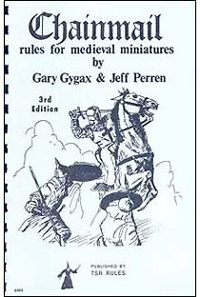 I’m an old TSR module fan, and as such I’ve always been intrigued by how the concept of such media came into existence. For the most part they fall in series, kind of like writers follow Tolkien with the concept of connected books and characters in a trilogy. It makes perfect sense, especially if you’re trying to create an extended campaign with a gaming group that meets on a regular basis. Series modules facilitate that, and recently I had the opportunity to chat with one of the original designers of a TSR foundation adventure path, the L Series ‘Lendore Isles.’
I’m an old TSR module fan, and as such I’ve always been intrigued by how the concept of such media came into existence. For the most part they fall in series, kind of like writers follow Tolkien with the concept of connected books and characters in a trilogy. It makes perfect sense, especially if you’re trying to create an extended campaign with a gaming group that meets on a regular basis. Series modules facilitate that, and recently I had the opportunity to chat with one of the original designers of a TSR foundation adventure path, the L Series ‘Lendore Isles.’
The author, Lenard ‘Len’ Lakofka is probably so ‘old school’ he’s beyond the term. His inclusion into the realm of RPGs predates the genre entirely, as he was a member of the International Federation of Wargaming. This institution came about in the sixties before the creation of Gygax’s Chainmail and was the original organizer of the first Lake Geneva Convention, i.e. GenCon in 1968.
At that first convention, people were playing Avalon Hill board games and Diplomacy during the Saturday only gathering, but that first year a chosen few were invited by Gygax to try Chainmail on the following Sunday after the convention was over. Lakofka was one of these founding fathers of the game.
From those humble beginnings, Chainmail would evolve into Dungeons & Dragons and Lakofka would continue to play the game with verve for the next forty years.
He ran campaigns for six years with such notable historic characters as Leomund and Nystul before branching into module writing. His continued love of the game and contact with Gygax brought him to the attention of TSR co-founder Brian Blume. Blume purchased three module designs from Len at a convention in Portland Oregon as the eighties dawned on TSR’s golden age. The price paid, a lofty sum of $10,500, something to chew on for any wayward freelance writer currently looking to score $0.03 cents a word from the few periodicals or publishers out there today.
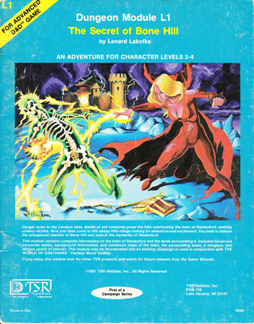 Although a fight ensued concerning the layout of the adventures, L1 The Secret of Bone Hill and L2 The Assassin’s Knot were released by TSR between 1981 and 1983. Lakofka worked with Gygax to locate the modules, and in turn the Lendore Isles, in the burgeoning World of Greyhawk.
Although a fight ensued concerning the layout of the adventures, L1 The Secret of Bone Hill and L2 The Assassin’s Knot were released by TSR between 1981 and 1983. Lakofka worked with Gygax to locate the modules, and in turn the Lendore Isles, in the burgeoning World of Greyhawk.
Lakofka recounts that he looked over a pencil map of Greyhawk and selected the Spendthrift Isles as the seat of his Lendore series because they had so little history currently written about them. It was a fine placement, and the Isles quickly solidified their place in the lore of the first true RPG campaign world.
L1 was an adventure based in the structural makeup of a wilderness setting. It places a party of adventures the small fishing town of Restonford, and has them sally forth to find adventure in the surrounding countryside. This is the same tried and true premise found in other classic modules of the time such as Douglas Niles B5 Horror on the Hill, Gygax’s B2 Keep on the Borderlands and T1 Village of Hommlet.
Lakofka himself ran Bone Hill on two separate occasions before it found its way to TSR, but as a standalone it falls somewhat short of where other modules of the time were hitting. Still, as in any series, L1 did its job, setting the stage for the richly textured L2 The Assassin’s Knot.
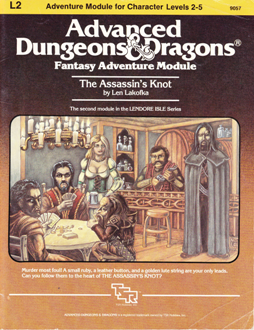 L2 created a greater ambiance to the Isles and introduced characters to the murderous village of Garrotten. This allowed the DM to further expand his campaign while also providing a murder mystery along the way. Instead of rooting around haunted forests, the adventurers discover evil and intrigue aplenty lurking in among the populace, and this gives a new and improved feeling to the Lendore Isles.
L2 created a greater ambiance to the Isles and introduced characters to the murderous village of Garrotten. This allowed the DM to further expand his campaign while also providing a murder mystery along the way. Instead of rooting around haunted forests, the adventurers discover evil and intrigue aplenty lurking in among the populace, and this gives a new and improved feeling to the Lendore Isles.
Although many players and DMs have voiced concern that as a stand-alone, the Knot is unplayable, I see it as an integral piece to a much larger tapestry. Lakofka explains that Knot actually details one of his weekly role-player’s character deaths, which I find intriguing to know not only that these modules were played but events inside them revolve around actual people’s characters. This admission also provided key insight into the subtle differences between L and other series; that being a sense of personal investment here rather than a writer simple sitting down and hand-crafting a dungeon crawl for the purpose of income.
Knot also found its way into the hearts of those who were integral in the creation of the game. In 2004, then Paizo owned Dungeon magazine released a list of the ’30 greatest Dungeons and Dragons modules of all time,’ in which Knot appears. If you’re interested, James Maliszewski did a great write up on the list for Grognardia that can be viewed here.
After the production of L2 there was a blowup at TSR, the Blume brother’s managed to oust Gygax from power, and L3 went into a drawer for the next fifteen years. It wasn’t until TSR’s acquisition by Wizards of the Coast that L3 The Deep Dwarven Delve saw publication.
Although Lakofka didn’t write Delve, he did design it, and the adventure adhered to the principles of 1st Edition AD&D and acted as more a guide than what you’d find in the other modules of the early eighties era. In this sense L3 become sterile, losing some of the playable charm of the first two modules, but it does provide the setting and if you’ve vested energy in the L1 or L2 you should be able to draw the flavor over into the vision of what Lakofka was seeking in Delve.
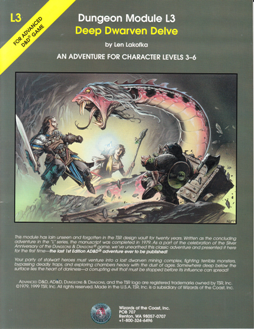 Most importantly however, L3 still brings about further exploration of Lendore, and in this running delve, the characters leave the relative comforts of Restonford and Garrotten for long-abandoned dwarven halls. The adventure is something of a cat and mouse, the DM working to keep the character’s guessing and low on stamina as they attempt to conquer the dark powers beneath the surface.
Most importantly however, L3 still brings about further exploration of Lendore, and in this running delve, the characters leave the relative comforts of Restonford and Garrotten for long-abandoned dwarven halls. The adventure is something of a cat and mouse, the DM working to keep the character’s guessing and low on stamina as they attempt to conquer the dark powers beneath the surface.
This rare module was released only with the Dungeons and Dragons Silver Anniversay Edition, and features the very first color work on any TSR product by artist Wayne Reynolds. Wayne, for his part, critiques his work on the project:
I always try to do the best work I possibly can on every piece of artwork I create. However, I’m hugely self-critical when it comes to past work and this piece of art is no exception. When I look at it now I can see a whole multitude of mistakes that immediately jump out at me – screaming to be corrected. Maybe because it’s an early piece that I perceive the mistakes as being quite bad. I suppose it’s all part of the artistic progression. So yeah… I hate it.
Yes, only Wayne could say something like that, but to any ran fan, Delve’s artwork is stellar, and he takes his place proudly alongside fellow L series alums Erol Otus and Bill Willingham.
L3 appeared in 1999, and Len continued to work out the details on Lendore a full decade after Delve’s late arrival on the scene. By 2009 he’d completed another piece of the series for Dragonsfoot, the 135 page monstrosity L4 Devilspawn.
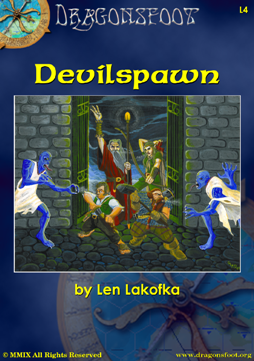 L4 takes Lendore and ‘explodes’ it with reference text. Lakofka defines his island world and provides players with ships to take them across it. This module is a labor of love, and I think anyone reading it can understand that. Gone are the days of the thirty-odd page adventure, and this module almost acts as a kind of Gazetteer for Lendore — although if you’re looking for a true Lendore Adventure Companion one can be found here.
L4 takes Lendore and ‘explodes’ it with reference text. Lakofka defines his island world and provides players with ships to take them across it. This module is a labor of love, and I think anyone reading it can understand that. Gone are the days of the thirty-odd page adventure, and this module almost acts as a kind of Gazetteer for Lendore — although if you’re looking for a true Lendore Adventure Companion one can be found here.
Lakofka speaks of Devilspawn as something that ‘grew and grew and grew like a Hydra growing too many heads.” Lucky for the fans, Dragonsfoot provides the full PDF for L4 on their website for free to anyone interested in further exploring Lendore. You can find it here.
As for Len creating any further additions to Lendore, he had this to say: “Wait till you see L5 it is even larger. One person said there is everything in L5 but the Kitchen Sink so I started to think of a way of putting in a magical sink… but that was going too far.”
This is classic ‘L’, the letter representing both Lakofka and Lendore, and for those who love adventure we are delivered by these wonderful creations. In its essence, L stands alone as unlike any other numbered series from that long lost generation of TSR games because it is still alive and well.
To that end, I leave you with the prospect of the future of the L Series from Len himself:
I’m puttering with parts of L6. The major area map is drawn and the towns named. Now it’s just filling it all in. There will be a major outdoor/underground adventure as well in L6. That is if I get busy and do it. There could be an L7 (eastern island coast), L8 Lo Reltarma (which was Loreltrama when I first did it) and L9 Asmogorgon and the Skull Peaks. Will those ever happen? Will I live into my 70s and still remember what I ate for breakfast? Tune in during 2015 and let’s see.
For my part, I hope 2015 treats you well Len, and that adventure always awaits.